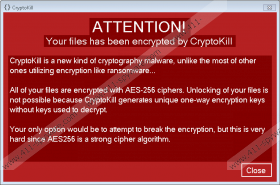CryptoKill Ransomware Removal Guide
CryptoKill Ransomware is a file-encrypting computer infection which has been, most probably, developed for testing purposes. Specialists do not consider it an infection which will cause much harm to hundreds of users because they have found that it searches for a test folder which should be located in %USERPROFILE%\Documents and works in it only. In other words, it encrypts files placed in this folder, so if such a folder does not exist on the system, it does not do anything harmful. Of course, it still opens a window with a message, but it can be easily closed. Even though the annoying window opened on Desktop can be dismissed, and CryptoKill Ransomware does not encrypt documents, pictures, videos, music, and other valuable files in other directories, it does not mean that it should be left on the system. Go to get rid of this ransomware infection the moment you find out that it is installed on your PC. Fortunately, the removal method will not be very complicated.
After carrying out research, specialists at 411-spyware.com are sure that CryptoKill Ransomware is not a unique threat. Instead, it is a poor copy of an open-source ransomware infection known as Hidden-Tear. Just like this infection, it uses the AES encryption algorithm to lock files, even though it works in the test folder located in %USERPROFILE%\Documents only. If it finds this folder and encrypts files by appending the .crypto extension to all of them, it also puts a CRYPTOKILL_README.txt file there. Last but not least, a window with a message is opened, as has already been mentioned in the first paragraph. This window will be visible no matter if files have been encrypted or not. Surprisingly, this threat does not offer users to purchase the key for decrypting files. Users are only told that their files are encrypted with the AES-256 cipher, and it is impossible to unlock them “because CryptoKill generates unique one-way encryption keys.” It is stated there that breaking the encryption is the only way to decrypt files. As has already been mentioned, CryptoKill Ransomware encrypts files in one folder which, most probably, does not even exist on ordinary users’ computers, so it is very likely that your files are fine, and you do not need to do anything. Click on the Close button to dismiss the window opened by CryptoKill Ransomware on Desktop and try to open your data. We are sure it has not been encrypted and you could access it.
This “cryptography malware”, as it calls itself, it not a popular infection, and it is very likely that it will not become one, but, of course, users should still know how ransomware is distributed. This knowledge might help people to prevent other ransomware infections from ending up on their computers. As researchers have revealed, CryptoKill Ransomware is usually spread through malicious emails. The file which launches this infection is usually spread as an email attachment. To make sure that users are not scared to open this email attachment, the malicious file is usually disguised as a harmless-looking document, e.g. an invoice. Stay away from emails received from unknown senders no matter if they contain attachments. Actually, CryptoKill Ransomware is only one of hundreds of other ransomware infections, e.g. Erebus 2017 Ransomware, Digisom Ransomware, and Cryptoconsole Ransomware, so you might encounter another ransomware infection that actually encrypts files. Go to install a security application on the computer to prevent this from happening.
Even though at the time of writing CryptoKill Ransomware encrypts files in only one folder, users might get infected with it but quickly find that nothing has happened to their files. To be frank, all the victims of this threat should go to erase it no matter their files have been locked or not because there is a slight possibility that it might be updated one day and then start encrypting files in other places too. Also, a ransomware infection will still be left active on the computer and might open its annoying red window on Desktop from time to time. To fully erase CryptoKill Ransomware from their PCs, users need to find the malicious recently launched file and then delete it. On top of that, the file CRYPTOKILL_README.txt should be erased from %USERPROFILE%\Documents\test, if this folder can be found on the system. A reputable automatic malware remover can erase CryptoKill Ransomware fully for you too.
Delete CryptoKill Ransomware
- Press Win+E.
- Check %USERPROFILE%\Downloads and %USERPROFILE%\Desktop.
- Delete the malicious recently downloaded file located there.
- Check if the test folder exists in %USERPROFILE%\Documents.
- Delete CRYPTOKILL_README.txt from this folder if it can be found there.
CryptoKill Ransomware Screenshots:



